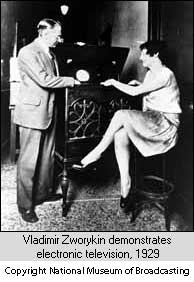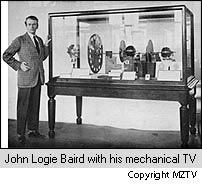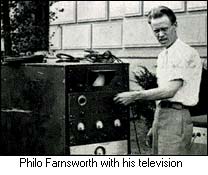Who is the inventor of television? You have really opened up a can of worms with that question! Probably no other invention in history has been so hotly disputed as the prestigious claim to the invention of 'Tele-vision or 'long-distance sight' by wireless.'
Since Marconi's invention of wireless telegraphy in 1897, the imagination of many inventors have been sparked with the notion of sending images as well as sound, wirelessly. The first documented notion of sending components of pictures over a series of multiple circuits is credited to George Carey. Another inventor, W. E. Sawyer, suggested the possibility of sending an image over a single wire by rapidly scanning parts of the picture in succession.
On December 2, 1922, in Sorbonne, France, Edwin Belin, an Englishman, who held the patent for the transmission of photographs by wire as well as fiber optics and radar, demonstrated a mechanical scanning device that was an early precursor to modern television. Belin's machine took flashes of light and directed them at a selenium element connected to an electronic device that produced sound waves. These sound waves could be received in another location and remodulated into flashes of light on a mirror.
Up until this point, the concept behind television was established, but it wasn't until electronic scanning of imagery (the breaking up of images into tiny points of light for transmission over radio waves), was invented, that modern television received its start. But here is where the controversy really heats up.
The credit as to who was the inventor of modern television really comes down to two different people in two different places both working on the same problem at about the same time: Vladimir Kosma Zworykin, a Russian-born American inventor working for Westinghouse, and Philo Taylor Farnsworth, a privately backed farm boy from the state of Utah.
'Zworykin had a patent, but Farnsworth had a picture''
 Zworykin is usually credited as being the father of modern television. This was because the patent for the heart of the TV, the electron scanning tube, was first applied for by Zworykin in 1923, under the name of an iconoscope. The iconoscope was an electronic image scanner - essentially a primitive television camera. Farnsworth was the first of the two inventors to successfully demonstrate the transmission of television signals, which he did on September 7, 1927, using a scanning tube of his own design. Farnsworth received a patent for his electron scanning tube in 1930. Zworykin was not able to duplicate Farnsworth's achievements until 1934 and his patent for a scanning tube was not issued until 1938. The truth of the matter is this, that while Zworykin applied for the patent for his iconoscope in 1923, the invention was not functional until some years later and all earlier efforts were of such poor quality that Westinghouse officials ordered him to work on something 'more useful.'
Zworykin is usually credited as being the father of modern television. This was because the patent for the heart of the TV, the electron scanning tube, was first applied for by Zworykin in 1923, under the name of an iconoscope. The iconoscope was an electronic image scanner - essentially a primitive television camera. Farnsworth was the first of the two inventors to successfully demonstrate the transmission of television signals, which he did on September 7, 1927, using a scanning tube of his own design. Farnsworth received a patent for his electron scanning tube in 1930. Zworykin was not able to duplicate Farnsworth's achievements until 1934 and his patent for a scanning tube was not issued until 1938. The truth of the matter is this, that while Zworykin applied for the patent for his iconoscope in 1923, the invention was not functional until some years later and all earlier efforts were of such poor quality that Westinghouse officials ordered him to work on something 'more useful.' Another player of the times was John Logie Baird, a Scottish engineer and entrepreneur who 'achieved his first transmissions of simple face shapes in 1924 using mechanical television. On March 25, 1925, Baird held his first public demonstration of 'television' at the London department store Selfridges on Oxford Street in London. In this demonstration, he had not yet obtained adequate half-tones in the moving pictures, and only silhouettes were visible.' - MZTV
Another player of the times was John Logie Baird, a Scottish engineer and entrepreneur who 'achieved his first transmissions of simple face shapes in 1924 using mechanical television. On March 25, 1925, Baird held his first public demonstration of 'television' at the London department store Selfridges on Oxford Street in London. In this demonstration, he had not yet obtained adequate half-tones in the moving pictures, and only silhouettes were visible.' - MZTVIn the late thirties, when RCA and Zworykin, who was now working for RCA, tried to claim rights to the essence of television, it became evident that Farnsworth held the priority patent in the technology. The president of RCA sought to control television the same way that they controlled radio and vowed that, 'RCA earns royalties, it does not pay them,' and a 50 million dollar legal battle subsequently ensued.
 In the height of the legal battle for patent priority, Farnsworth's high school science teacher was subpoenaed and traveled to Washington to testify that as a 14 year old, Farnsworth had shared his ideas of his television scanning tube with his teacher.
In the height of the legal battle for patent priority, Farnsworth's high school science teacher was subpoenaed and traveled to Washington to testify that as a 14 year old, Farnsworth had shared his ideas of his television scanning tube with his teacher.With patent priority status ruled in favor of Farnsworth, RCA for the first time in its history, began paying royalties for television in 1939.
Philo Farnsworth was recently named one of TIME Magazine's 100 Greatest Scientists and Thinkers of the 20th Century.
References:
- The United States Patent Office patent interference #64,027
- The Pioneers of Electronic and Mechanical Television
by MZTV - The Birth of Television
by the VideoUniversity.com - Who invented television?
by Paul Schatzkin - On John Logie Baird
by Jones Telecommunications & Multimedia Encyclopedia
Answered by: Stephen Portz, Technology Teacher, Space Coast Middle School, FL
No comments:
Post a Comment